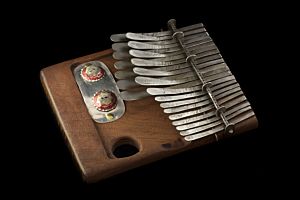Mbiras
Mbira is the name of the most widespread version of the African language musical instrument, which has a thousand-year history and has only recently become known in the rest of the world as "Kalimba" (simplified version). In his homeland, Mbira is not just a musical instrument - it is an important part of culture and religion, an intermediary between a person and the spirits of ancestors.
The main distinguishing features of Mbira are the location of the tongues and the fingering associated with it. The keyboard is divided into three parts - the lower left row is in lowercase, the upper left is in the middle and the right row in the right. In some settings, there are small deviations - individual tongues may not be in their places. The tongues of the left half are pressed with the thumb of the left hand. 3 (4) of the left tab on the right side are pressed with the large hoop of the right side, and the rest with the forefinger, and from the bottom up.
The hole in the body serves to fix the instrument, which is located vertically on the knees, little finger. The average size of the mb is 20-25 centimeters and the weight is about a kilogram - the retention technique here becomes quite important. Mbira lamels are traditionally tough and require considerable efforts to press. The timbre of sound differs markedly from the gentle "home" kalimbas - two main "reed" components are strongly separated in it: a primary, rapidly decaying, explosive high sound and a subsequent quiet and smoothly departing singing.
The obligatory component of Mbira sound, like any African instrument, are shakers whose sound is no less important than the sound of reeds.
And, of course, we can not fail to mention the system - the "notes" of original African instruments differ from those used in modern European music and do not lend themselves to standardization in this system. In addition, that there is no exact binding to the absolute altitude ("A = 440 Hz"), there are no fixed interval ratios. The scale is created for a specific melody, which in itself is not a one-off, fixed, song, but the basis for a whole world based on a multitude of rhythmic, melodic and harmonic variations. The names of many common mbir scales are nothing more than the names of works that exist and are transmitted by millennia - for example, Nyamaropa, Mavembe, Dongonda.

 Russian
Russian
























